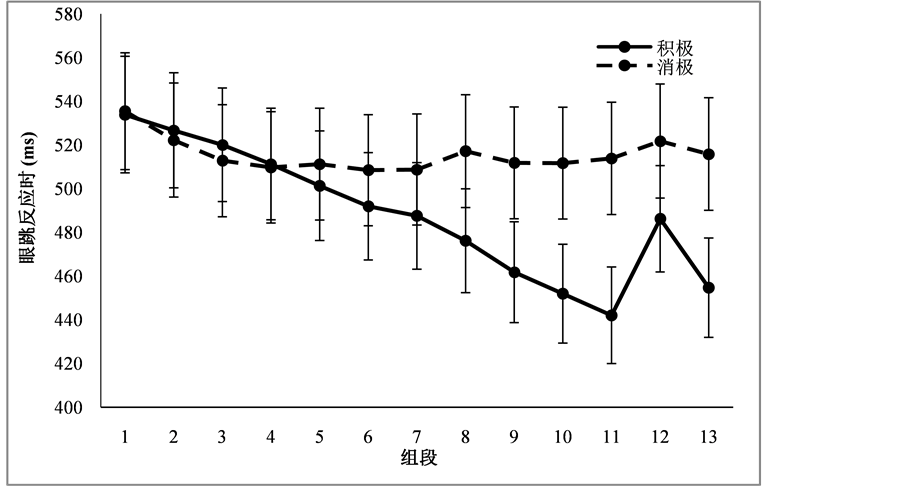1. 引言
生活处处有情绪,常见的情绪状态如积极和消极情绪,对学习、记忆、注意等认知活动有着显著的影响。已有研究表明,消极情绪干扰或破坏外显学习,而积极情绪则对外显学习起着促进作用。而情绪与内隐学习关系的实证研究却不多,且已有研究结果存在争议,不同的研究者基于不同的理论观点或同一理论的不同角度进行解释。此外,由于内隐学习和外显学习未共享同一认知系统(Borbély-Ipkovich, Janacsek, Németh, & Gonda, 2014),因此情绪和内隐学习的关系需要进一步探究。
Naismith, Hickie, Ward, Scott和Little (2006)在序列反应时任务中发现,与控制组相比,患有严重抑郁即沉浸于消极情绪中的病人表现出序列反应时学习效应的减少,其内隐学习成绩只有控制组的一半。但是抑郁等情绪障碍涉及许多加工缺陷,其结果不能为情绪对内隐学习的影响提供直接的证据,因此后续的研究者在健康人群中进行了研究。在健康人群被试中,研究者多以情绪图片或情绪面孔图片为诱发情绪的材料,也有研究以成语为刺激研究积极和消极语义刺激对内隐序列学习的影响,结果发现积极情绪的内隐学习量显著大于消极情绪的内隐学习量。Shang, Fu, Dienes, Shao和Fu (2013)为了避免被试在序列反应时任务中习得外显知识,因此将多维度的概率性序列作为序列学习材料,用积极和消极情绪的音乐片段启动情绪,结果发现消极情绪减少序列反应时任务的内隐学习。以上研究表明,积极情绪促进内隐序列学习,消极情绪干扰内隐序列学习。
相反,也有研究发现积极情绪会削弱内隐学习,消极情绪则起促进作用。Pretz, Totz和Kaufman (2010)以国际情绪图片系统中的图片来启动情绪状态,采用了两种被广泛使用的内隐学习范式:人工语法范式和序列反应时范式。研究结果显示消极情绪促进人工语法学习,但是情绪对序列反应时学习没有显著影响。这可能是因为这两种任务涉及不同的加工过程且需要学习不同的结构。Dienes, Baddeley和Jansari (2012)在研究一种快速测定内隐学习速率的方法时,发现被消极情绪短暂诱发的个体有更高的内隐学习速率,他们学得更快,而被开心情绪诱发的被试学得更慢。这也为消极情绪对内隐学习的促进效应提供了证据。
由上可见,不同的研究者对情绪与内隐学习的关系持有不同的观点。已有研究存在以下不足:第一,已有研究中主要是采用积极和消极的视、听觉材料作为主要实验材料,如具有情绪效价的词语、语音和乐音以及一般图片和情绪面孔图片等来启动情绪。但这些材料都存在着较大的个体差异和性别差异,可能会影响情绪启动的效果,如情绪面孔图片就混合了相貌等诸多因素可能会干扰实验结果。Montagne, Kessels, Frigerio, Haan和Perrett (2005)研究发现,在表情面孔方面,女性拥有着比男性更强的区分能力,并且,不同个体对于视频、音乐的理解和感受也存在着较大差异。使用音乐片段诱发情绪也存在缺陷,如果实验时间过长,其诱发效果可能会消退。被试在游戏中会因任务的成功或失败引起特定情绪,基于此,也有研究者尝试在实验中通过游戏诱发情绪,但此种方法较为局限,只能激发因成功或失败而产生的情绪;第二,已有研究无论是关于内隐学习还是外显学习,多是采用阈上启动情绪的方式,这种外显的情绪启动方式在一定程度上会占用较多的认知资源,对认知活动产生阻碍作用进而影响到实验结果。Mackie和Worth (1989)提出“认知资源占用说”,认为个体的认知资源是有限的,但是积极情绪和消极情绪都会在一定程度上诱发与当前的认知任务无关的思维活动,从而与认知任务本身竞争有限的认知资源,对认知任务的表现产生不利的影响;第三,已有研究需要被试做出按键反应。按键反应受到较多因素的影响,如不同的年龄阶段、不同的身体状况的个体其按键反应会有较大差异。Helmuth, Mayr和Daum (2000)发现患有疾病的个体与健康的个体之间手的反应速度存在差异,年轻人和老年人在进行按键反应时手的反应速度也存在一定差异。因此,采用传统的按键反应研究序列学习存在一定的局限性。针对已有研究不足,本研究将从以下三方面进行改进:
第一,本研究将通过对刺激的大小进行操纵来产生接近(近距离)和远离(远距离)的视觉效果,以启动相对的消极和积极的情绪。这种启动情绪的材料存在较小的个体差异且被证明是有效的:Hsee, Tu, Lu和Ruan (2014)通过改变字母的大小来产生接近、远离的视觉效果及不改变字母大小来产生静止的效果,给被试呈现字母后要求被试评估他们的感受,从非常消极到非常积极七级计分。结果发现了接近厌恶效应,即当个体感觉到一个刺激在接近他们而不是静止或远离时会体验到更多的消极情绪,无论这个刺激最初是消极的还是非消极的。研究者认为该效应可能是进化的结果,在长期的生存斗争中人们习得了,与静止和远离的刺激相比,接近的刺激有着更大的威胁和危险;另外Williams和Bargh (2008)考查了空间线索对个体情绪反应的影响。被试被要求在笛卡尔坐标系上画出相应的两个坐标点,以此来启动相应的空间远近距离,随后被试阅读一篇令人尴尬或暴力的文章片段,并评估他们对这个片段的喜欢程度或当前的情绪状态。结果发现,与那些被远距离启动的被试相比,被近距离启动的被试更厌恶令人尴尬的文章片段;被远距离启动的被试比被近距离启动的被试报告了更少的消极情绪。由已有研究可得,物理上远近的空间表征的激活会影响人们的情绪;空间距离概念的激活会调节随后刺激的情绪性影响。第二,本研究采用阈下情绪启动即使快速呈现刺激的方式来诱发情绪。阈下情绪启动与阈上情绪启动相比具有一些优点(吕勇,张伟娜,沈德立,2010):阈下情绪启动对记忆系统具有更小的激活作用;阈下情绪启动的作用大于阈上情绪启动,即通过无意识获得的、知觉到的信息更多地作用于人的情绪;意识情境下的情绪可能能够被特定的认知加工唤起,但也可能受到另外的认知加工的抑制作用(程九清,高湘萍,2004)。廖声立和陶德清(2004)指出,阈下呈现即快速呈现和掩蔽呈现情绪刺激材料是无意识情绪启动的两种主要方式,且无意识情绪启动在许多信息加工领域得到了证明。第三,为了控制传统按键反应产生的干扰,本研究使用眼动技术,记录被试实验过程中的眼跳反应时,要求被试既快又准地看靶子刺激所在的位置。眼跳反应时即眼跳潜伏期,指从目标刺激出现到被试做出第一次眼跳之间的时间间隔,能够反映出被试执行眼跳的时间。已有研究证实,与传统的反应时指标一样,眼跳反应时指标具备同样的功能,是衡量序列学习情况的有效指标。Kinder, Rolfs和Kliegl (2008)研究发现,在被试进行序列学习时,规则序列组块的眼跳反应时呈逐渐减小趋势,但是突然插入一个随机序列时,眼跳反应时会有显著的增加。该实验结果提示,眼跳反应时和传统的反应时的数据结果一致,能够有效、充分地反映被试内隐和外显序列学习的情况。
本研究采用单因素被试间实验设计,自变量为阈下情绪启动,因变量为眼跳反应时。采用序列学习范式,通过快速呈现接近和远离的刺激以阈下启动相应的消极和积极情绪,进一步探究情绪对内隐序列学习的影响。
2. 实验方法
2.1. 被试
在大学共招募了40名被试(14名男性,26名女性,年龄为20.83 ± 1.5岁)参加实验。所有的被试有着正常的视力或矫正视力,均为右利手且母语为中文,未参加过类似的内隐序列学习实验。被试被随机分到积极情绪组和消极情绪组。被试在完成实验后会得到一份小礼物。
2.2. 实验材料
2.2.1. 情绪启动材料
屏幕中央有一个灰色的正方形,呈现时间为200 ms (从占屏幕的10%至20%为25 ms,占屏幕的20%至30%为25 ms......以此类推)。阈下消极情绪启动组:灰色正方形最初占屏幕的10%,一直到占屏幕的90%;阈下积极情绪启动组:灰色正方形最初占屏幕的90%,一直到占屏幕10%。
2.2.2. 序列学习材料
屏幕中央从左至右水平排列有四个一样的黑色方框,背景为白色。在规则序列组段中黑色圆点以一定的顺序规则出现在其中一个方框里,在随机序列组段中则是随机地出现在其中一个方框里。
正式实验共包括13个组段,每个组段包括96个试验。其中第12个组段为随机序列组段,其他组段为规则序列组段,即黑色圆点出现的位置遵循一定的序列规则:D-A-C-B-A-B-D-C-A-D-B-C。A, B, C, D分别对应着显示器屏幕从左至右排列着的四个黑色方框的位置。每一个规则序列组段中的起始圆点位置是随机的,但不会出现两个圆点连续出现在同一位置的情况。
2.3. 实验设计
采用单因素被试间实验设计。其中,自变量为阈下情绪启动,有两个水平:阈下消极情绪启动、阈下积极情绪启动。因变量为眼跳反应时。
2.4. 实验仪器
采用EyeLink 1000 plus眼动仪来记录眼动轨迹,采样率为1000 Hz。实验材料呈现在19英寸的惠普电脑上,显示器分辨率为1024 × 768像素,刷新率为75 Hz。被试眼睛距离显示器中央之间的距离约60 cm。被试双眼注视显示器,但只记录右眼的眼动轨迹。实验程序采用Experiment Builder 1.1进行编制。
2.5. 实验程序
整个实验流程包括准备、正式实验和实验后的意识性水平测试三部分,如图1所示。
1) 第一部分即实验正式开始前的准备:进入实验室的被试被随机分到阈下积极情绪启动组或阈下消极情绪启动组。简要向他们介绍眼动仪,使被试对仪器和实验有个大致了解。接着,让被试坐在眼动仪前,双眼平视显示器屏幕,将下巴放在下巴托上并要求被试在实验过程中尽量保持头部不动。
2) 第二部分即正式实验:首先,对被试的眼睛进行五点校准。成功校准后开始实验。显示器屏幕上呈现指导语:“您将在电脑屏幕上看到四个黑色方框,黑色圆点将会出现在其中一个方框里。请既快又准地注视黑色圆点,成功注视后电脑会自动翻屏。按空格键开始实验。”正式实验前被试先进行练习,
练习中随机呈现圆点的位置,直到被试理解指导语后才开始正式实验。黑色注视点“+”在屏幕中央呈现250 ms,紧接着呈现诱发情绪的刺激材料200 ms,给阈下积极情绪启动组快速呈现逐渐远离的刺激,给阈下消极情绪启动组快速呈现逐渐接近的刺激,然后呈现黑色圆点。每个组段结束后被试可以短暂休息。
3) 第三部分即意识性水平测试:正式实验结束后,被试要完成纸质的意识性水平测试。根据过程分离程序,意识性水平测试包括包含任务和排除任务,通过被试在两个任务中的得分可以评估他们进行了内隐学习还是外显学习。其中,包含条件下给被试呈现规则序列中圆点的两个相邻位置,要求被试尽量根据记住的序列规则填写出下一个位置,填对1个位置得1分;排除条件下则要求被试尽量避免根据他们所记住的顺序填写,若被试仍然根据圆点位置的实际顺序规则填写,那么每填对1个位置得1分。
3. 实验结果
根据被试在意识性水平测验的得分,筛选出内隐被试。其中,包含条件的得分小于3分,或者包含条件得分小于或等于排除条件得分的被试为内隐被试,不满足以上条件的被试为外显被试(吕勇,胡伟,吴国来,沈德立,2008)。10名外显被试数据被剔除。使用眼动数据分析软件“Data Viewer 1.1”对无效的眼动数据进行剔除。最终有效的内隐被试共30人,阈下积极情绪启动组15人,阈下消极情绪启动组15人。使用SPSS 21.0软件对被试的眼跳反应时数据进行分析,阈下积极情绪启动和阈下消极情绪启动的眼跳反应时见图2所示。
对1-11组段眼跳反应时进行2(组别:阈下积极情绪启动、阈下消极情绪启动) × 11(组段:1-11)方差分析,结果表明:组别主效应显著,F(1, 28) = 11.81, p < 0.01, η2 = 0.30,阈下积极情绪启动组眼跳反应时(491 ms)显著低于阈下消极情绪启动组(515 ms)。组段主效应显著,F(10, 280) = 9.68, p < 0.01, η2 = 0.25,随着组段增加,眼跳反应时显著减小。组段和组别交互作用显著,F(10, 280) = 5.99, p < 0.01, η2 = 0.17,简单效应分析表明,阈下积极情绪启动组眼跳反应时随着组段增加显著减少,F(10, 140) = 13.34, p < 0.01, η2 = 0.49。阈下消极情绪启动组眼跳反应时差异不显著(p > 0.05)。
对阈下积极情绪启动和阈下消极情绪启动条件下的内隐序列学习量进行F检验,内隐序列学习量计算方法为第11组段和第13组段眼跳反应时平均数与第12组段眼跳反应时的差值(Nissen & Bullemer,

Figure 2. Saccadic RT in subliminal negative and positive emotion priming
图2. 阈下积极情绪启动和阈下消极情绪启动的眼跳反应时
1987)。结果表明阈下积极情绪启动和阈下消极情绪启动内隐序列学习成绩量差异显著,F(1, 28) = 11.41,p < 0.01, η2 = 0.29,阈下积极情绪启动条件下内隐序列学习成绩(37.8 ± 16 ms)显著高于阈下消极情绪启动条件下的内隐序列学习成绩(6.9 ± 31 ms)。
4. 讨论
本研究采用内隐序列学习范式和眼动技术来研究情绪对内隐学习的影响。实验中以快速呈现情绪材料的方式来阈下启动情绪,利用图形大小的变化产生相应的积极和消极情绪,并记录实验过程中被试的眼跳反应时。实验结果显示,阈下积极情绪启动被试的眼跳反应时显著低于阈下消极情绪启动的被试,阈下积极情绪启动条件下被试的内隐序列学习成绩显著高于阈下消极情绪启动条件下被试的内隐序列学习成绩。该结果与已有的一部分研究一致(Naismith, Hickie, Ward, Scott, & Little, 2006; Shang et al. 2013),表明积极情绪对内隐序列学习具有促进作用。值得注意的是,结果发现组段主效应显著,随着组段增加,眼跳反应时显著减小;组段和组别交互作用显著,简单效应分析表明,阈下积极情绪启动组随着组段增加眼跳反应时显著减少,但是阈下消极情绪启动组眼跳反应时差异不显著。如果被试进行了序列学习,那么规则序列组段的眼跳反应时会随着组段逐渐减小,在插入的随机序列呈现时,眼跳反应时会增加。本研究中,阈下积极情绪启动组前4个组段的序列反应时逐渐减少,而后序列反应时比较稳定,且随机序列的呈现并没有造成显著的眼跳反应时增加。该结果反映了阈下积极情绪启动组的被试进行了序列学习,而阈下消极情绪启动组的被试序列学习效应不显著。阈下消极情绪启动组被试前4个组段的眼跳反应时下降,可能是由熟悉效应和练习效应造成的。阈下消极情绪启动组不存在序列学习效应,可能是因为消极情绪引导数据驱动加工,关注当前的特定项目。而序列学习任务存在一定的规则,每个项目与其他项目共同形成12个顺次的规则,被试内隐地获得该规则后会产生序列学习效应。所以被消极情绪启动的被试倾向于仅对当前的项目做出反应,而不能将其与更多的项目联系起来,难以获得序列规则,表现为眼跳反应时差异不显著。
我们认为与消极情绪相比,积极情绪对内隐序列学习有着有利的影响,起促进作用。研究者们根据拓展–塑造理论(Fredrickson & Branigan, 2005)认为,积极情绪能够扩展个体的注意力范围,思维更灵活,能更好地看到整体,且较少地占用认知资源,因此对内隐序列学习有促进作用;而消极情绪局限了个体的注意范围,加工的范围有限。以该理论解释研究结果的前提是,内隐序列学习受到注意范围或注意程度的影响。有研究表明,对于内隐序列学习,注意资源并不是必需的。相关的眼动证据也指出,注意负荷的高低并不一定影响内隐序列学习的效果(卢张龙,吕勇,白学军,2011)。但是,付秋芳和傅小兰(2006)提出,如果是以内隐学习成分为主的较复杂的序列学习任务,其所需的注意资源较少,但如果序列学习任务比较简单,其对注意资源的需求会变大,这就是“动态需求”假设。与人工语法任务相比,序列学习任务相对简单,但是实验中采用的是结构性较低的序列,被试可能会意识到部分的序列规则但无法意识到全部的序列,对于完成任务时需要多少注意资源无法确定。因此,拓展-塑造理论不能很好地解释结果。
另一方面,情绪信息假设(Shang et al. 2013)指出,消极情绪关注自下而上的加工,倾向于加工特定的项目和当前的细节,所以处于消极情绪中的被试难以将圆点位置的顺次整合起来,不利于获得序列的规则;而积极情绪与自上而下的加工以及关系加工相关联,倾向于将新信息整合进已有的知识中以获得整合性信息,所以积极情绪组的被试更擅长获得序列学习中圆点位置的顺序规则。因此,该假设在一定程度上能够解释实验的结果。另外,积极情绪倾向于依赖图式和启发式,消极情绪偏向分析式加工、因果推理及系统加工(Bodenhausen, Kramer, & Süsser, 1994)。根据双重过程理论(Pham, 2007),内隐学习是内隐系统的功能,内隐系统的加工是无意识的,整体的,不费力的,联系的和启发式的。因此,与启发式相联系的积极情绪能够促进内隐序列学习并不奇怪。此外,个体在完成任务时的表现会受到动机水平的影响。Aarts等(2008)认为,当目标刺激与不同的情绪状态相联系出现或同时启动时,会产生不同的影响。就这一点来说,在阈下积极情绪启动条件下的被试与阈下消极情绪启动条件下的被试相比,往往具有更高的动机水平和更大的行动力。我们认为,积极情绪提高了被试参与任务的动机水平,因而被试能够更好地完成任务且成绩更好。
5. 结论
本研究得出如下结论:1) 阈下积极情绪对内隐序列学习具有促进作用;2) 阈下消极情绪干扰内隐序列学习。